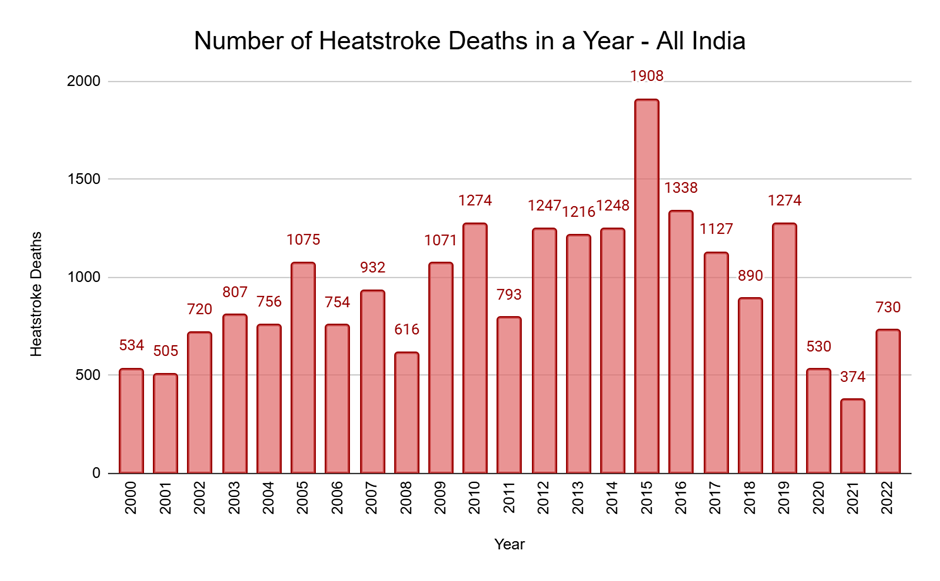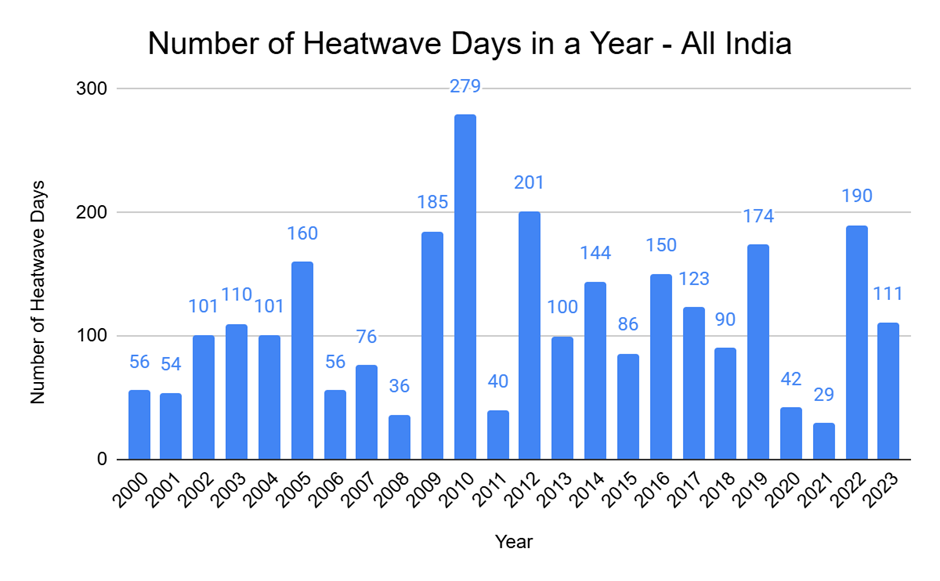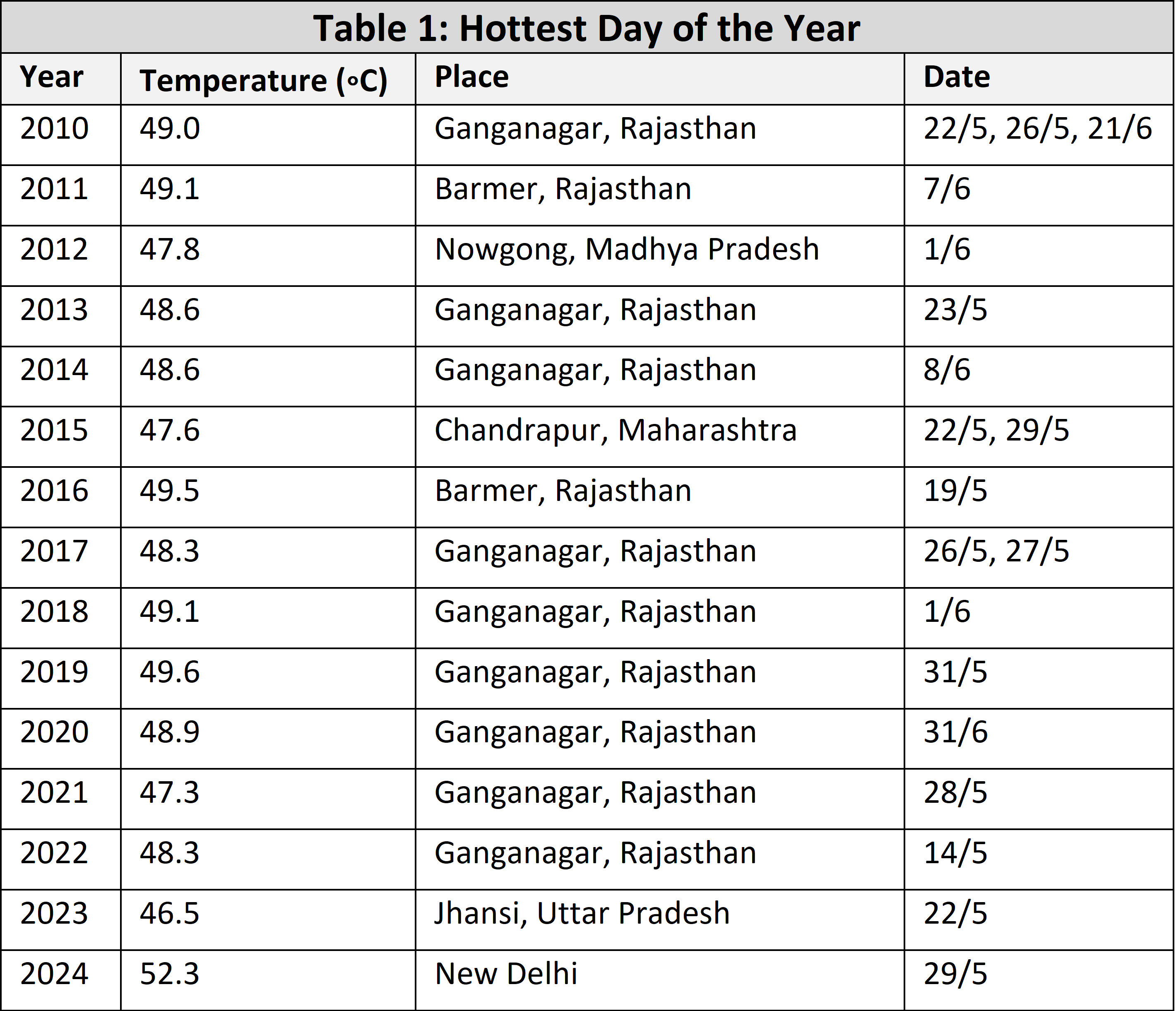Heatwaves in India are becoming more frequent and intense in India, affecting both human life and animal life. The summer of 2024 saw several states grappling with persistent heatwaves and temperatures rise past 50 C in some areas. Media reported 143 cases of heatstroke deaths and more than 41,000 heatstroke cases – which is likely a fraction of the cases gone unreported.
The crisis highlights several underlying problems. There is a severe lack of resources – institutional, financial, and physical – to mitigate the risks of heatwaves. Inadequate housing, with poor ventilation and cooling, exacerbates the vulnerability of populations, particularly those without stable homes who live in makeshift shelters. Since many of the impacted people depend on their daily wages to survive, this problem is also closely related to food security.
The data on heatwaves
Heatwave mortality data in India is inconsistent, with variations between figures from different government agencies. We take the heatwave mortality data from the National Crime Records Bureau (NCRB), which record such deaths under the head of ‘Accidental Deaths and Suicides in India’.
The data shows that heatwaves are a perennial issue worsening over time. (Figure 1) show that the heatwave deaths in India has been substantial, exceeding 1,000 deaths annually during various time periods.
Figure 1: Trend in Heatstroke Deaths Annually- All India

We also track the data on heatwave days. The total of such days across various regions in 2024 was 446, the highest recorded so far since 2000, according to data from EnviStats of the Ministry of Statistics and Programme Implementation (Figure 2). The previous peak was 279, in 2010, but no trend is visible from the data.
Figure 2: Trend in Heatwave Days in a Year - All India

Since 2010, the hottest day of the year has consistently exceeded 47 C (with the exception of a marginally lower peak in 2023), with Ganganagar in Rajasthan qualifying as the hottest place for various consecutive years. New Delhi broke all records in 2024 with maximum temperature crossing

Vulnerability and adaptive capacity
These trends and statistics point out the stark reality of the impact of global warming in a tropical country like India.
Like other calamities, the impact of extreme heat is dependent upon the population's vulnerability. The most affected groups are those whose work exposes them to heat – such as construction workers, domestic workers, farmers, daily wage labourers, street vendors – or whose circumstances render them vulnerable – homeless people, children, differently abled, old age people, people with chronic illness – or those who are more sensitive to heat, and have a lower capacity for adaptation.
Policy makers in charge of heat coping and adaptation need to be aware of the disparity in how different population segments perceive heat risk and the decisions taken should reflect those experiences and local knowledge.
There are multiple socioeconomic and demographic determinants that trigger and contribute towards heat stress vulnerability. Individuals and communities that are poor, socially isolated, or live alone have fewer resources and support systems to reduce their risk from extreme heat. People with pre-existing health conditions respond poorly to heat stresses. There is also a close relationship between heat vulnerability and the quality of housing. Homes and buildings without adequate ventilation, high-quality construction materials, and an efficient cooling system are more vulnerable.
The interlinkage of food security and heat vulnerability too is critical. Incomes are hit when workers cannot work due to extreme heat waves, making it more difficult for them to afford food. Moreover, rising food prices and low nutritional intake can further steer heat stress vulnerability.
The scope for policy interventions
Given India's limited ability for adaptation and high current exposure to heat waves, the effects of more frequent heat waves could be extremely critical. Yet, coping mechanisms and adaptive capacity have not been fully operationalised through the frameworks that have been developed in the literature on sustainability, resilience, and public health. The lack of institutional, financial, or physical resources to reduce the risks associated with heat waves further curtails the adaptive capacity of the vulnerable and high-risk populations and communities.
We highlight some policy prescriptions:
1. The IMD, World Health Organization, and World Meteorological Organization have in recent years developed warning and monitoring systems in India and across the globe. The data, advisories and alerts from these sources are extremely useful for public health monitoring and prevention, but they do not capture individual adaptation behaviour to heat.
2. Short term coping mechanisms (e.g., heatwave awareness and preparedness through warnings and advisories such as staying indoors and staying hydrated, staggered timings of workplaces and educational institutions, colour-coded temperature alerts) should be complemented with long term adaptive capacity building (access to water, electricity, healthcare, etc. for the vulnerable sections, setting up institutional support systems accessible to vulnerable groups). Resilience building through community support and social inclusion is also important as a part of the policy response.
3. Heat adaptation: cooling neighbourhoods and cities through development of ventilation corridors, proper urban designing such as taking care of spacing between buildings, urban greening, etc. are some strategies which will help mitigate heat in the long run. However, given the severe heatwave conditions coupled with inadequate infrastructure, India has a long way to go when it comes to heat mitigation.
4. Call for more research: Adaptive capacity and heat vulnerability analysis and their applications opens new research opportunities
5. Comprehensive targeting: Mapping vulnerable communities and their practices to adapt to heatwaves
6. Heatwave mortality data should be standardised and consistent across different government agencies.
The Availability of resources and taking steps to mitigate and adapt to the extreme heat is a complex problem for both people (specifically vulnerable sections) and those wanting to assist them (the state and NGOs). Targeted heat mitigation and adaptation policies will be widely adopted if it is known how and when vulnerable people are motivated to make the necessary changes to improve thermal comfort and protect public health. Policy makers in charge of heat coping and adaptation need to be aware of the disparity in how different population segments perceive heat risk and the decisions taken should reflect those experiences and local knowledge. Moreover, lack of commitment to sustained action may fail to translate even a high adaptive capacity into effective adaptation.
Naresh Singh is professor and executive dean of Jindal School of Government and Public Policy, and director of the Centre for Complexity Economics and Applied Spirituality for Public Policy, OP Jindal Global University, Sonipat, Haryana. Priti Agarwal is an assistant professor at Jindal School of Government and Public Policy. Geeta Sinha is an associate professor at Jindal School of Government and Public Policy.












